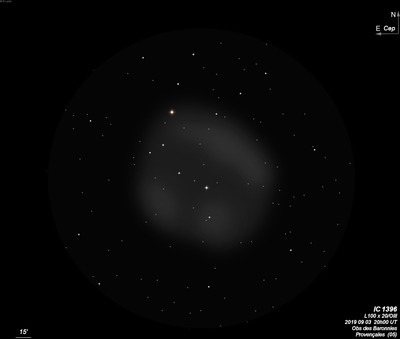
16x80 (9/29/84 and 8/26/89): using a UHC filter appears as a very large, irregular nebulous glow (about 2° diameter). Very faint but definite when compared without filter. Surrounds ∑2816 = 5.8/7.7 at 12" and a large, faint, scattered star group. Visible without a filter as an extremely large, hazy region surrounding ∑2816 and fainter stars.
E.E. Barnard discovered IC 1396 on a photographic plate taken with the Willard lens in 1893. He commented in "Photographic Nebulosities and Star Clusters connected with the Milky Way" (Astr. & Astro-Phys. 13, 177-182 (1894)) that "A magnificent specimen of these [nebulous masses] I have found on one of my plates in Cepheus which was given an exposure of seven hours. This a mixture of bright stars and nebulosity. The diffused portion of this nebulosity conforms in its peculiarities with the general structure of the Milky Way, showing it be actually mixed up with the ground work of star. The brightest star of this group is DM +56° 2617."
400/500mm - 18" (7/11/10): Barnard 161 is an easy 6' circular dark patch within IC 1396 (north of center) just 13' N of ∑2819 = 7.4/8.7 at 13" and 25' NE of the triple star ∑2816 = 5.8/7.7/7.8 at 12" and 20". Stands out fairly well at 73x. There are extensions to the north of this cometary dark nebula that I didn't see.
Notes by Steve Gottlieb